University of Fashion’s all-inclusive lesson on sewing needles, pins, thimbles & pincushions. (Image credit: University of Fashion)
A Love Letter to Sewing Tools
Small but mighty, pins and needles are the divas of the sewing world—tiny, pointy, and always ready for drama. While AI is out there trying to take over the planet, these little metal sticks have been stabbing fabric (and fingers) into submission for centuries. They’re the unsung heroes of fashion, holding everything together while designers take the credit. So today, I’m dedicating this blog to the real MVPs—those sharp, shiny troublemakers no sewist can live without.
Pins, needles, thimbles and pincushions are the silent partners in every designer’s creation, the instruments that connect imagination to material form. Understanding them is one of the foundational steps in mastering the art and craft of fashion design.
A Stitch Through Time
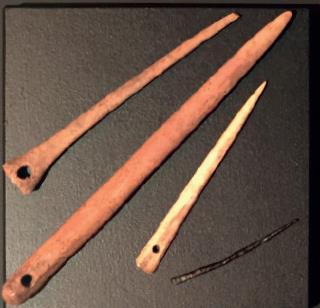
Examples of early bone needles. (Image credit: Sewing Techniques for Beginners by Francesca Sterlacci)
The Oldest Art Form
The story of needles and pins traces back to the Paleolithic period when early sewing needles were made from bone, ivory, or wood, carefully carved to pierce animal hides with animal sinew (fibrous tissue that joins muscle to bone) used as thread. As man learned to use metals, needles gradually came to be made from copper (7000 BCE), bronze (2500 BCE) and iron (1200 BCE). By the 14th century, steel needles became standard, but it wasn’t until 1755 that the first patent was awarded for a needle with an eye. Each evolution of these small instruments mirrored the development of human ingenuity and craftsmanship.
Knowing Your Tools: The Professional Edge
Fashion professionals know that mastery comes not just from creativity, but from understanding materials and tools. The right combination of needle, pin, thimble and thread can determine the difference between frustration and finesse. For example, a Glovers needle with its sharp, tri-point tip makes hand-sewing leather & leather-like materials a breeze.

A Glovers needle for hand-sewing leather & leather-like materials. (Image credit: Artisan Supplies)
The Needle: Precision in Motion
When you take the time to learn about your sewing tools, their purposes, care, and selection, you don’t just improve your craftsmanship, you join a lineage of makers who have built entire wardrobes, traditions, and stories from the simplest of beginnings: a piece of fabric, a few pins, and the perfect needle.
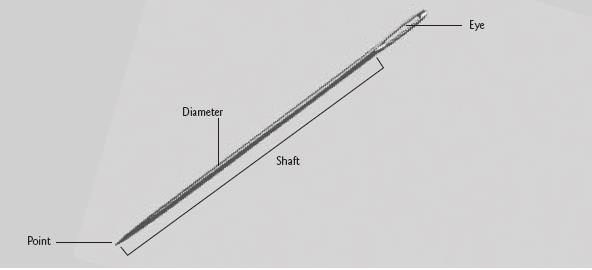
Hand-sewing needle anatomy. (Image credit: Sewing Techniques for Beginners by Francesca Sterlacci)
A sewing needle might appear simple, but its design is the result of centuries of refinement. Every part has a purpose—the eye that holds the thread, the shaft that passes through fabric, and the point determines how it penetrates material. The diameter, the length, and the eye of the needle all play a role when choosing the best needle for your project.
Hand-sewing needles come in many forms:
-
- Sharps needles – for general hand stitching and fine dressmaking
- Betweens/Quilting needles – for quick, tight stitches
- Beading needles – long, fine needles used for beads, sequins and basting
- Embroidery/Crewel needles – with larger eyes for thicker threads
- Tapestry needles – with blunt tips for working through open weaves
- Glover’s needles – with triangular points for leather & leather-like materials
- Milliners/Straw needles – a long hand-sewing needles used for gathering, smocking, basting & millinery work
- Chenille needles – similar to tapestry needles but with very sharp points
- Darning needles – also known as cotton darners for mending
- Appliqué needles – used in patchwork & appliquéing
- Yarn darners – thick needle with blunt tip for mending and joining knit & crochet pieces together
- Upholstery needles – long, heavy needles, straight or curved for upholstery work
- Sailmaker needles – similar to Glovers needles but the triangular point extends further up the shaft
- Doll needles – the longest needle with a long eye fused in doll-making, soft sculpture and upholstery

#7 Sharps — The most common hand-sewing needle. (Image credit: John James)
Sharps are a general-purpose sewing needle. They are the most common needle used by dressmakers around the world. Their short round eyes are easier to thread and provide added strength during sewing.
The general rule is — the bigger the number the finer and shorter the needle.
Sharps in sizes 2, 3 and 4 are used for general sewing on medium to heavy fabrics. These sizes have a larger eye and therefore are easier to thread. Sharps in sizes 5, 6, 7, 8, and 9 are the most popular within the sharps community and are commonly used for general sewing on light to medium fabrics. Sharps size 10, 11 and 12 are often referred to as the ‘petite needle’ because they are very fine and short with smaller eyes than their counterparts within the Sharps family. These needles are ideal for creating small delicate stitches and are quick and easy to use, a delight for the experienced sewer.
Lockstitch Sewing Machine Needles: Domestic & Industrial
Machine needles are even more specialized than hand-sewing needles and the best way to learn about them is to view our video, Intro to Needles, Pins, Thimbles & Pincushions. Since sewing machine needles are available for domestics (home sewing machines), as well as industrial machines, there are many more things to consider when choosing the correct needle, such as needle class, cataloging system (European metric sizing (NM) or American sizing), needle point and color-coding system. Selecting the correct sewing machine needle for your machine, fabric type and thread weight, ensures clean, strong stitches and helps prevent skipped stitches or damage to your material.
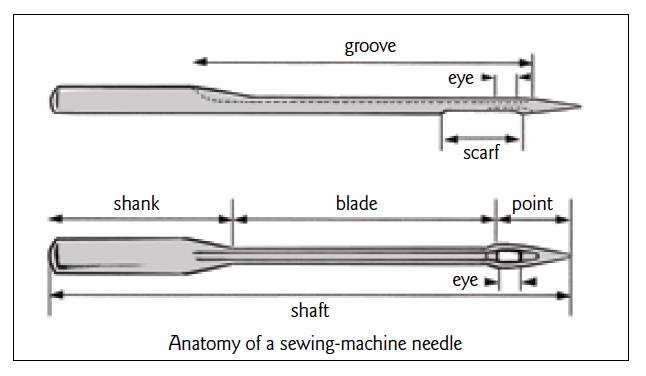
Anatomy of a sewing machine needle (Image credit: Sewing Techniques for Beginners by Francesca Sterlacci)
A sewing machine needle is made up of several parts. The shank is the top of the needle, which is inserted into the machine. The shaft is the body of the needle below the shank, and the groove is the slit that runs down one side of the needle to its eye. The scarf is an indentation above the eye, on the opposite side of the needle to the groove. A long scarf helps eliminate skipped stitches by allowing the bobbin hook to loop the thread more easily. The eye is the hole through which the thread passes, and the point is the needle tip below the eye. The point of the needle is shaped to provide the most suitable penetration of the material being sewn, according to its nature and the desired stitch effect. Domestic-needle shanks are flat on one side, while industrial needle shanks are fully round and slightly longer than domestic needles.
The lower the sewing machine needle number, the finer the needle — the lighter the fabric weight. The higher the needle size, the larger the needle — the heavier the fabric weight.

Types of Domestic & Industrial sewing machine needles. (Image credit: Sewing Techniques for Beginners by Francesca Sterlacci)
Types of lockstitch sewing machine needles include:
-
- Universal needles – handle everyday fabrics
- Ballpoint needles – slide between knit fibers without damaging them
- Denim needles – puncture heavy fabrics cleanly
- Embroidery needles – have larger eyes and special coatings for decorative threads
Pins: The Designer’s/Sewist’s Invisible Hand
Pins are the first point of connection between a designer’s vision and physical fabric. They shape fabric drape, hold patterns in place, and guide the construction process before a single stitch is made. Whether they are used for draping, pattern making or sewing, choosing the appropriate pin head, thickness and tip is always important.
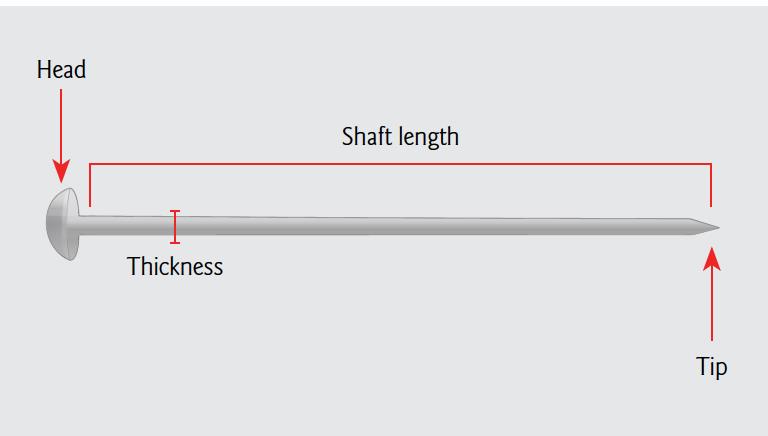
Anatomy of a straight pin. (Image credit: Sewing Techniques for Beginners by Francesca Sterlacci)
Types of pins include:
- Dressmaker pins – used in draping, sewing and pattern making.
- Flathead pins – good for open weave fabrics because the large flat head keeps them from getting lost in the work.
- Glass – head pins are favored for their heat-resistant tips, ideal when pressing.
- Silk pins – glide smoothly through delicate fabrics without leaving visible holes.
- Ballpoint pins – made for knits.
- Quilting pins – longer and designed to grip multiple fabric layers easily.
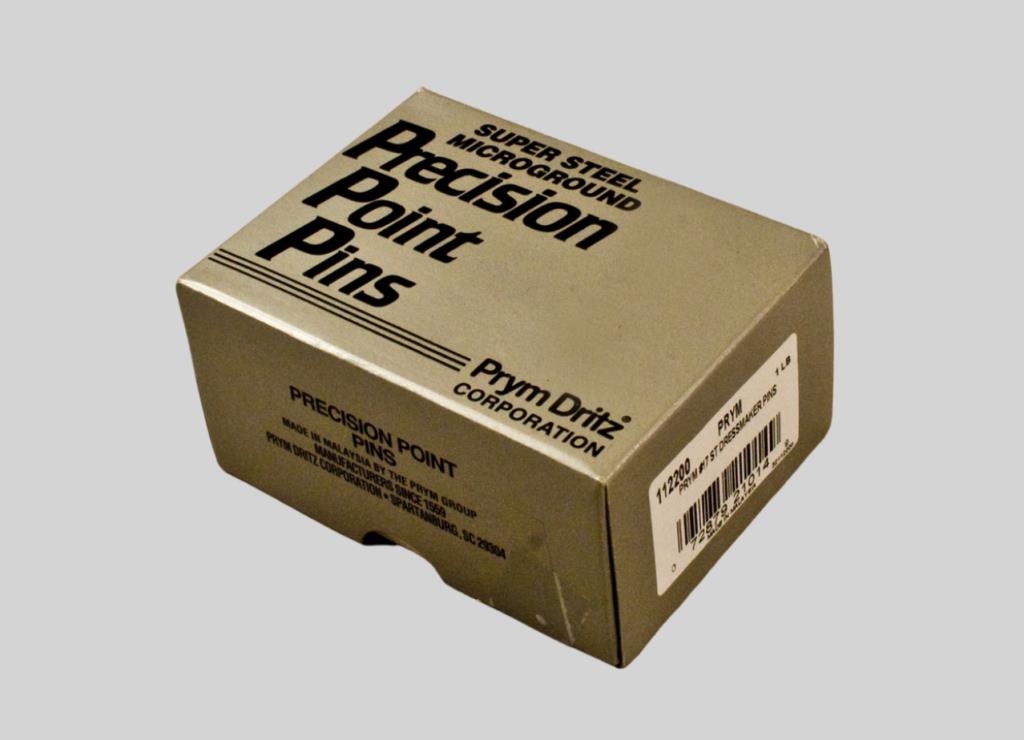
#17 Dressmaker straight pins are ideal for draping, pattern making and sewing projects. (Image credit: Sewing Techniques for Beginners by Francesca Sterlacci)
Good-quality pins make a noticeable difference in precision work. They should slide smoothly and resist bending—small signs of craftsmanship that make large impacts in final quality.
The Companions: Thimble and Pincushion
No discussion of needles and pins is complete without mentioning their essential accessories—the thimble and pincushion. A thimble protects your finger as you push a needle through stubborn fabrics. They come in metal, leather, and silicone variations, each offering different levels of comfort and control. Seasoned sewists often have a favorite they can’t work without.

Assorted thimbles-Top left to right: domed (brass), flat top, open top and band thimble. (Image credit: Sewing Techniques for Beginners by Francesca Sterlacci)
The most popular models with dressmakers are dome-top thimbles, while flat-top thimbles are used by quilters, and open-top and band thimbles are preferred by tailors. Thimbles consist of nickel-plated steel with dimpled surfaces that “grab” the end of a needle, providing the leverage for it to be pushed easily through the fabric.
Pincushions
Meanwhile, the pincushion serves both function and charm. Beyond keeping needles organized, it protects their sharpness by providing a soft resting place. Traditional tomato-shaped pincushions often include an attached strawberry stuffed with emery—a fine abrasive that cleans and sharpens needle tips. A magnetic pin holder serves as storage and for gathering up pins that have fallen. A wrist pincushion is very convenient especially when draping and available in pincushion or magnetic models.

Assorted pincushion options: Small & large tomato, magnetic cup & wristband. Image credit: Sewing Techniques for Beginners by Francesca Sterlaci)
Fashion professionals know that mastery comes not just from creativity, but from understanding materials and tools. The right combination of needle, pin, thimble, and thread can determine the difference between frustration and finesse.
When you take the time to learn about your sewing tools—their purposes, care, and selection—you don’t just improve your craftsmanship. You join a lineage of makers who have built entire wardrobes, traditions, and stories from the simplest of beginnings: a piece of fabric, a few pins, and the perfect needle.
For more on sewing tools get our companion book, Sewing Techniques for Beginners. It is filled with tips and tricks, and follows along, step-by-step, with our videos:

Available on Amazon: (Image credit: Sewing Techniques for Beginners by Francesca Sterlacci)
-------------------------------------
By: Francesca Sterlacci
Title: Points of Perfection: The Designer’s Tiny Powerhouses
Sourced From: www.universityoffashion.com/blog/points-of-perfection-the-designers-tiny-powerhouses/
Published Date: Sat, 15 Nov 2025 13:21:56 +0000
Read More
Did you miss our previous article...
https://edmmusic.news/fashion-clothing/untangling-the-mysteries-of-thread
 FestivalsMusicNew ReleasesArtistsFashion & ClothingVideosPrivacy PolicyTerms And Conditions
FestivalsMusicNew ReleasesArtistsFashion & ClothingVideosPrivacy PolicyTerms And Conditions
